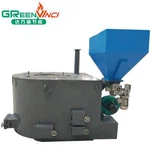People have used biomass energy—energy from living things—since the earliest “cave men” first made wood fires for cooking or keeping warm. Today, biomass is used to fuel electric generators and other machinery.
Here, we would like to show you some biomass energy.
(RE:https://education.nationalgeographic.org/resource/biomass-energy)
Briquettes

Before biomass can be efficiently burned, it must be dried, a process called torrefaction. Torrefied biomass is shaped into briquettes, like these made from wood waste in Nairobi, Kenya.
Making Charcoal

Pyrolysis is a method of heating biomass that involves warming the material without the presence of oxygen. Making charcoal, like these kilns in Malaysia, is one of the oldest and most familiar pyrolysis methods.
Charcoal Worker

Pyrolysis produces biochar, a type of carbon-rich charcoal. Biochar is used in agriculture, as it prevents soil from leaching pesticides and other nutrients. This worker is making charcoal for individual heating and cooking needs in rural India.
Pyrolysis Products

Pyrolysis also produces pyrolysis oil, also called biocrude. Pyrolysis oil can be incorporated into other fuels, as well as used in plastics. Here, Helena Chum, Center Director in the Center for Renewable Chemical Technologies and Materials, poses with pyrolysis oil, its products and the biomass from which it was made.
Gasification

Biomass can be directly converted to energy through a process called gasification. During gasification, a biomass feedstock is heated with a controlled amount of oxygen. This gasification plant in Maui, Hawaii, converts sugar cane to electricity.
Syngas

Gasification produces slag and syngas. Slag is a molten liquid that can be used to make asphalt. Syngas, examined by this worker at a test facility, can be converted to liquid fuels such as methanol, mixed alcohols, and diesel fuel.
Anaerobic Decomposition

Biomass can also be broken down by the process of anaerobic decomposition. In this process, microorganisms (usually bacteria), "digest" biomass materials in the absence of oxygen. Anaerobic decomposition produces methane, an important alternative fuel source.
Landfill Sludge

Anaerobic decomposition is one of the most popular methods to process municipal solid waste (MSW). This pile of "black sludge" on the island of Saipan is ready to be transported to tanks filled with anaerobic bacteria, which will digest the sludge and produce methane. The same process can be used to convert manure on ranches and farms, cleaning the area and helping meet the energy needs of the farm.
Biofuel

Fuel made from oil crops is called biofuel. The demand for biofuels has grown in recent years because of rising gas prices, concerns about global warming, and a desire for energy self-sufficiency. Biofuel made from sugar or corn crops can be used as a fuel for vehicles, like this car.
Black Liquor

One of the most successful uses of biomass energy is black liquor, a toxic material produced in the paper-milling process. Black liquor, seen here in a lab, used to be dumped into local waterways as a waste product. Today, the paper industry uses nearly all its black liquor to run its mills.
Fuel Cells

Biomass is rich in hydrogen, which can be chemically extracted and used to generate power and fuel vehicles. Here, a mechanic installs a set of fuel cells into a car. Hydrogen fuel cells are used to power buses, forklifts, boats, and submarines.
Canola Fields

Resplendent in spring bloom, a canola crop colors fields in the Western Cape’s fertile Overberg region. The Overberg lies at the continent’s southernmost tip, where the Indian and Atlantic Oceans converge.
Algal Fuel

Algae, being examined by a biotechnologist at a lab, has enormous potential as a biomass feedstock. Algae, whose most familiar form is seaweed, produces energy up to 30 times faster than crops such as corn and soy.
Energy Crops

Biomass energy is energy generated or produced by living or once-living organisms. The most common biomass materials used for energy are plants, such as corn and soy, above. The energy from these organisms can be burned to create heat or converted into electricity.
Feedstocks

Some of the leading biomass feedstocks include: (top row) switchgrass, copra (coconut), cotton, jatropha; (middle row) municipal solid waste (msw), sunflowers, palm nuts, canola; (bottom row) wheat, sugar cane, wood, and rice.







